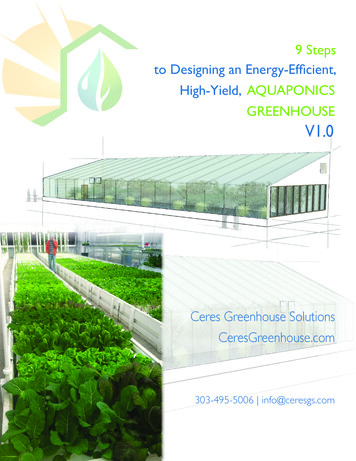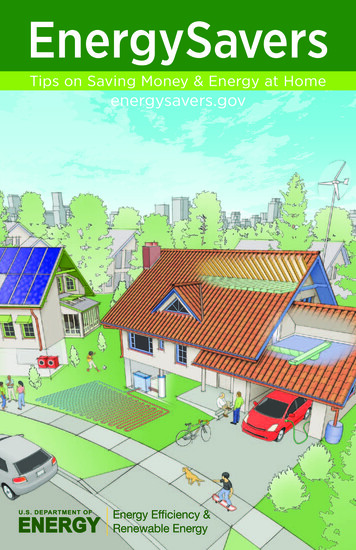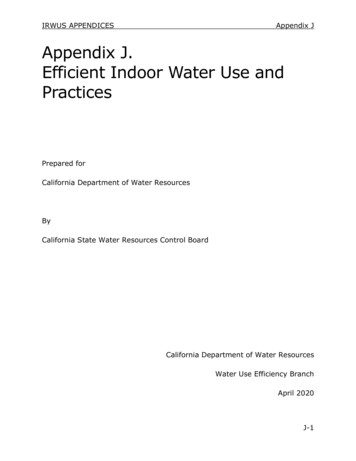
Transcription
9 Stepsto Designing an Energy-Efficient,High-Yield, AQUAPONICSGREENHOUSEV1.0Ceres Greenhouse SolutionsCeresGreenhouse.com303-495-5006 info@ceresgs.com
ABOUT CERESAt Ceres, we design and build greenhouses that save energy, water and money. CeresGreenhouse Solutions started with the idea of applying energy-efficient building design togreenhouses (notoriously inefficient structures). The result is a ‘greener greenhouse’ -- one thatoperates independently, with less fossil fuel energy and less hassle. In addition, our greenhousescan be built for any wind / snow load, making them incredibly durable and long-lasting. Becausethey are energy-efficient, durable and customizable, we’ve found our greenhouses to be anatural fit with aquaponics growers. This has led us to continue to refine and develop ourdesign for aquaponics, and, as of now, share what we’ve learned along the way.ABOUT THIS GUIDEThis guide is intended to provide a framework for you to design an abundant, profoundlyproductive, cost-effective aquaponics operation. And, to help you avoid some of the pitfalls alongthe way. Since our specialty is energy-efficient greenhouses, we spend a lot of time discussingwhat greenhouse growers don’t often think about before they begin: saving energy. While weare located in the Rocky Mountains, the tips below can be applied to greenhouses in any climate,particularly those with harsh winters. Of course, they will need to be tailored: Growers in Floridawill not need as much insulation as growers in Maine, for example. We’ve also aimed to provideadvice for operations of all sizes, from residential to commercial. Thus, this guide is intended toprovide general overview for planning your aquaponics greenhouse, which you will have to fleshout for your own application. We are always available if you need assistance.JOIN THE CONVERSATION:Help us, and your fellow aquaponic growers, get better by letting us know what you think. Was thisdocument helpful? What else would you like to know? What didn’t pertain to you? Email us yourfeedback at info@ceresgs.com303-495-5006 info@ceresgs.comCeresGreenhouse.com
Questions to ask: How do I want to grow? How much space do I need?Start by establishing what you want from your aquaponics greenhouse -- how much space youneed and what type of system is best for you. If starting from scratch with a new greenhouse,you can design around your aquaponics system and create an initial floor plan from there. Decidehow many beds and fish tanks you will need room for. Keep in mind to make space for potting /work tables, a sitting / teaching area, a hammock. Greenhouses can be for more than just plants!Some greenhouses (like CERES Aquaponics models) already have pre-existing designs and plans foraquaponics systems. If buying a kit greenhouse or working with an existing greenhouse, then you’llhave to plan your system around that. When designing your floor plan,DODON’Tplace beds where there will be direct light,like in front of South facing windows.place fish tanks fully in direct light ifpossible. The tanks accumulate toomuch heat for fish. While it’s alwayspossible to heat the fish tanks if needed,it’s much more difficult to cool them.You especially want to keep the surfaceout of direct light if possible – sunlightcan cause algae growths on warm water.If light does hit the tank, you may wantto consider putting a covering over thetop. For this reason, in solar greenhousedesigns (those with an insulated Northwall and light predominantly comingin from glazing on the South) tanks onthe North wall, such as the NW or NEcorner, is generally a good location.Use the corners. Most fish tanks are roundtanks which makes them inherentlyawkward in a square greenhouse. Youcan use oval fish tanks. To best maximizespace, think about putting the fish tanks inthe corners.Above: Think about multiple uses of a greenhouse,whether relaxing, harvesting, or teaching.Right: Example of a well-designed aquaponicsgreenhouse with beds along the South wall, and fishtanks and sump tanks along the North wall.how to design an aquaponics greenhouse1Sketch out your floor plan
The roof is also partially insulated to keepdirect light off the fish tanks.2Design a smart, durable greenhouseQuestions to ask:What do I want to grow and when? What minimumtemperatures do I need? Snow loads and wind loads? Does my sitehave access to Southern light?TipWhen it comes togreenhouses, you can’talways use standardbuilding materials.Greenhouses arenaturally humidenvironments, andwhen temperaturesdrop at night all thewater vapor willcondense on surfacesinside. Thus, we don’trecommend woodsiding. Wood anywherein the greenhouse needsto be stained or paintedwell. Cedar is often thebest for roof beams. Weuse an interior sidingcalled MagnesiumOxide that is made ofa mineral and is waterresistant (Ask us forsourcing information).Other materials areplastic, metal orfiberglass sidings.If you want to save yourself a lot of time and headaches, design anenergy-efficient, thermally stable greenhouse. This means a structurethat does not fluctuate wildly in temperature as much as regulargreenhouse does. For example, take this standard PVC greenhouselocated in Boulder CO, and how it performed over the course of aday in November. In one day it froze at night (30 F) and then heatedup to over 100 F. Plants, like people, are not going to like theselarge temperature swings. While you can tame this environment byconstantly heating and cooling the greenhouse, you’ll save yourself alot of money and hassle in the long run by starting off with an energyefficient structure. Thus, follow these basic principles to designing anenergy-efficient greenhouse. The fish will thank you.how to design an aquaponics greenhouseLeft: Beds along a South wall will be moreproductive; tanks along an insulated Northwall will keep water temps more stable.Note how the North East wall (where thewater heater and electrical equipment arelocated) is a standard insulated wall in this23’ x 40’ greenhouse. Water heaters needto stay warm; they don’t need light!
Tip:Insulate!We can’t stressthis enough. Inmost places withharsh winters(continually freezingnights) insulate thegreenhouse as youwould a normalstructure like yourhouse. We usebetween an R-21and R-50 insulatedwalls. See our videoat ceresgs.com to seethis in action.5. Insulate around the perimeter of the greenhouse. Generally, go4’ down (vertically) or out (horizontally) from the base of thegreenhouse to reduce heat loss through the floor.6. Harness excess solar heat in the greenhouse during the day,and store it using thermal mass (active or passive) for cold evenings -- this evens out the naturaltemperature swings problematic in greenhouses. To make the most out of thermal mass combine itwith a heat exchanger which circulates air through the thermal mass and back into the airspace ofthe greenhouse. See more info on our Ground to Air Heat Transfer System (GAHT) online.7. Design proper natural ventilation systems8. Use materials intended for greenhouse (i.e. humid) environmentsEach of these points could be a booklet in itself, so use our other resources online or email us fora copy of our “Beginners Guide to Greenhouse Design” for more information. These provide thebasic overview of smart greenhouse design. From there, tailor the greenhouse according to yourgrowing system using the rest of the steps below.Left: A well-designed energy-efficientgreenhouse has glazing (glass orpolycarbonate) facing South and usesinsulation on the remaining sides.This greenhouse grows tomatoes andwarm weather crops year-round at9,000 ft elevation in Colorado withlittle to no extra heating.how to design an aquaponics greenhouse1. Create an air-tight, insulated, and energy-efficient structure2. Face glazing where the light comes in (South), and insulate whereit doesn’t (North and some of the East and West). For mostclimates with harsh winters this cannot be overstated.3. Reduce excess heat gain in the summer by using lowertransmission glazing on the roof -- like a diffuse or thicker rigidplastic. Sun in the summer and shoulder months is much moreintense and will overheat the greenhouse. It comes in at a higherangle (from the roof). Diffuse some of this light with lowertransmittance plastics, or by adding shade cloth.4. Likewise, increase heat gain in the winter by using highertransmittance glazing on the South wall. Winter sun comes in ata low angle, and during this time you want to capture as much ofthis light and heat as possible.
3Decide on flooringQuestions to ask: Do I want to move things around (have things onwheels)? Is it important to clean the floor? How much do I want to spend?Concrete:This is the most expensive option, but probably the nicest long-term. It creates a level andpermanent surface for all your systems, as well as an easy surface to wash down and clean. It willneed to have a surface drain, and remember factor in any areas that need to be recessed in thefloor, like sump tanks or inset fish tanks (see tips 5 and 6).Gravel (picture below):A good middle of the road option. It creates a level surface with good drainage but can be hard towalk on or move things across. If you want to move your beds or tanks and are considering havingthem on wheels, this is not the way to go.Pavers or Stone:Flagstone, or any of the pavers at the local hardware store, isalso a great middle of the road option. Looks nice, drains welland creates a level surface.Dirt:Not the best, but will do.You are more prone to bug issues,and keep in mind that dirt under the weight of large sumptanks or water tanks will compact over time. Make sure tocompact the floor before installing systems so that tanks andbeds will stay level. Even with a stone, gravel or dirt floorinstalling a floor drain is a good addition.Keep in mindthe location and layout of your pipes when planning yourflooring. It’s nice to have these buried so you don’t trip overor step on and break exposed plastic lines (photo right). Oryou can raise your walkways to a level walking surface.how to design an aquaponics greenhouseSome options:
Questions to ask: How much bed space do I need? Type of system (raft,NFT, media beds, or wicking beds)?There are lots of different systems out there – either DIY or pre-arranged kits. We’re not goingto go into recommendations for the systems themselves (see our resources page online tolearn more from suppliers or DIYers, or email us if you have a specific question). But here’s animportant point to keep in mind for beds in a greenhouse:Know your bed heightand make an insulated knee wall below the top of your beds. There isno need for glazing below the beds. The greenhouse will only loose heatthere at night, exposing the bottom of the beds and the root systemsto cold air at night, or too much heat gain during the day. You want tokeep your beds and root systems at a stable temperature, and the bestway to do this is to not put them next to glass or plastic. If buildingyour own greenhouse or buying a custom design, identify the heightof your beds (usually hip height or 2-3’ above ground) and design thegreenhouse with a framed insulated knee wall up to the sill of the beds(see photo bottom left). If you have a kit greenhouse or are workingwith an existing greenhouse, you can install rigid foam board insulation(aka poly-iso, brand name R-max) along the wall under the beds. Cutit to the size of the area you have beneath the beds and secure it on thewall. Try to layer boards to get as high of an R-value as possible.Floating raft systems(photo top andbottom right) areoften well-suited forgreens and plantswith lower nutrientrequirementswhereas media bedsystems (bottomleft) are best forfruiting plantsand plants withhigher nutrientrequirements. Seeour resources pageat ceresgs.com formore info on whichis best for you.how to design an aquaponics greenhouse4Plan for your beds
Consider Using Vertical SpaceBy using the vertical space in the greenhouse,you can add much more production area -- justthink: in a 10’ x 10’ greenhouse (100 sq. ft.), if youplant along the whole 10’ high North wall you’veadded another 100 sq. ft. and doubled (!) yourpotential growing area. Of course, it’s hard toplant an entire wall with planters, but many newproducts and systems are coming out to makethat easier. Here’s a few options: Growing towers or columns like the ZipGrowplanters from Agrotech (photos top left andcenter) are popular with aquaponics growers.They can be scaled up for large, commercialsystems. Wall planters or other small-scale systems likeWooly Pocket, gSky, or Live Wall can be sold asindividual units for residential greenhouses. Seeour blog comparing the various systems. DIY systems -- And then there’s all the funstuff: rain gutters, recycled plastic bottles, tiersand trellises of every shape. Again, see our blogfor more ideas and instructions for making yourown recycled soda bottle planter (top right) orother suggestions on good planters.Need help?We’re here to help you plan and designyour aquaponics greenhouse the rightway, the first time. Whether you need afull design including building plans andinstructions, or just an hour of phoneconsultation, we provide a range ofservices to help you through the processto create the highest-yield, most energyefficient greenhouse possible, for bothresidential and commercial operations.Email our aquaponics expert for moreinfo: Josh@ceresgs.comhow to design an aquaponics greenhouse4.1 Grow up
6Plan for fish tanksThe sump tanks need to be a certain height beneaththe grow beds. This varies based on how much wateris being pumped into the beds. Talk to your supplier to seewhat the recommended depth of the sump tank is. If the sumptank needs to be buried, keep this in mind when thinking aboutflooring options. I.e. if using a concrete floor leave a space openfor the sump tank before pouring the pad. First identify whatheight you would like your beds to be at and work from there.As we noted earlier, try to keep fish tanks out of direct light: it’s much easier to heattanks than to cool them.You’ll want to place your fish tanks near electrical outlets,or make sure you can run power to the tank for heaters and air circulation. In addition, you canchoose between burying your fish tanks partially underground, or having the tanks above ground.Some considerations.Undergroundtanks have the advantage that you can build a platform over the tank and use it forgrowing space, or potting / work space. The soil also acts as natural insulation. But,underground tanks come with the obvious disadvantage that the tanks are difficult toclean / empty-- you’ll have to rely on a sump pump or shop vac, or design for a deepdrain.Above groundtanks make it easier to clean the tanks -- necessary every once in a while in everyaquaponics operation. You can still build a platform over the tanks (see top rightphoto) but your height is limited for plants there.Tip: Insulate your tanksInsulate around your fish tanks to prevent from getting too cold. Usebubble wrap or flexible insulation (right). You also want to insulateunderneath the tank, but remember the weight of the tank can breakrigid insulation. Larger aquaponic operations can even have a separatedinsulated room on the north side of the greenhouse for tanks.how to design an aquaponics greenhouse5Plan for sump tanks
Questions to ask: How much stuff will I be running? What is going tobe the total power draw?Every aquaponics system is different and thus there is huge variation on electrical requirements.To help you (and / or your electrician) plan for the electric system, calculate the total energyusage or load of the components in your system. Find the wattage of each component. The majorenergy users to think about: Water pumpsWater heater (size of your heater will depend on the heating requirement. N/A if using apropane heater or other independent system)Aeration pumpsElectric space heaters (the size of your heater in turn depends on your greenhouse, location,required temps etc. See below. N/A if using a propane heater or other independent system).Ventilation and circulation fans (primarily your exhaust fan)Lights if using themOnce you know the wattage of each component, you can calculate your electrical requirementneeded for the greenhouse. Add up the wattage of each component. Then divide the total byyour voltage. This will give you the total amps needed for the greenhouse. From there, talk to anelectrician about your electrical design. Generally, if using wiring for 20 amps, you can take thetotal amperage, add a 15% safety factor, and then divide by 18 (again, giving some room so youdo not blow the fuses) and round up to the next whole number to determine your number ofcircuits. Simplified example:Water heater (2000 W) 2 Lights (200 W each) 2400 W total2400 W / 120 v 20 amps20 amps plus 15% 23 amps23 amps / 18 amp circuit 1.3You’ll need 2 circuits. But again, if you’re not an electrician, don’t try to wire this.Going Off-GridYou have the same options with hooking up your aquaponics system as with any new electrical system.You can a) connect to the grid via your home, or nearby structure or b) build an off-grid system withsolar PV. Building an off-grid system can be an e-book in itself - stay tuned via our newsletter for this.Generally, your options are creating a grid-tied system (feeding power back into the grid), a stand-alonesystem or a stand-alone system with battery back-up (recommended if doing a stand alone system). Youcan ALSO connect the greenhouse to the grid for electrical, and incorporate an off-grid method just forheating, like solar hot water.how to design an aquaponics greenhouse7Plan for electrical
Where to start?1. First you have to know what you want to get out of the greenhouse.what plants and howmuch. How big does it need to be to produce what you would like?2. Then go to the structure. How do I create an environment that will make these plantshappy? Tomatoes are different than kale. Cold hardy micro-greens have different needs thantropical fruit trees. If going for a large variety, aim to please the plants that need the warmesttemps. With greenhouse design there are different general strategies: the “cheap upfront /expensive long-term” route, or the “invest more upfront / reap the energy savings over time”approach. Obviously, we recommend the latter after seeing people loose money on renovatingor starting over after using low-quality, energy hogging greenhouses. You should have ageneral idea of how your greenhouse is going to perform, and how difficult or easy it will beto control. To get a better idea talk to other growers in your area, or talk to us about an energyanalysis of the structure.3. Once you have a rough idea of your air temps inside, go to your aquaponic system. If youanticipate your greenhouse will track air temps and you live in Montana, you will need asizable water heater. If you are planning a well-insulated greenhouse that utilizes thermalmass, are in a moderate climate, and choose the right fish species, may not need a water heaterat all.4. From here, you can finish out the system: electric requirements, water hook-ups., additionalaccessories like lights and exhaust fans.8Some Design IdeasHere are a few example floor plans for residential and small-scale commercial orcommunity greenhouses, using Ceres solar greenhouse designs. Each has been optimized for theclimate and the system, to maximize space and to create an incredibly productive, energy-efficientgreenhouse. These will vary by location and your aquaponics system, but can give you some ideasfor your own design / layout.Right and next page: A 920 sqft greenhouse has (22) 3’ x 3’beds, and (3) 130 gallon fishtanks.how to design an aquaponics greenhouseAs you can infer from the above points, when planning a greenhouse one thing dependswhich depends on another which depends on another, ad infinitum. If starting from scratch,here’s a good game plan:
(1) 180 gal fish tank and (2) 130 gal sump tanks (sold asthe 5 bed Easy Reach Aquabundance System from TheAquaponics Source)Above: A 12 x 16 greenhouse with (7) 3’ x 3’ grow beds,(1) 180 gal fish tank and (2) 130 gal sump tanks (sold asthe 7 bed Easy Reach Aquabundance System from TheAquaponics Source)how to design an aquaponics greenhouseAbove: A 10 x 12 greenhouse with (5) 3’ x 3’ grow beds,
1. In the winter, light will come through the windows at a low angle from the South.Therefore, put shorter plants along the South side of the greenhouse so they donot shade the plants in the back. Likewise, put taller things – vines, tomatoes, trees – along theNorth wall. Many plants prefer the ‘morning light’ – the light coming from the East – for growingcompared to the Western afternoon light, which often overheats greenhouses and wilts plants.Thus, if debating which side to put your fish tank on, a well-insulated North West corner isgenerally the best.2. Watch the windows / glazed walls: the they will get much colder than other spots in thegreenhouse. Plants on or near the windows / polycarbonate / plastic walls will get much colderthan those planted a few inches inside the air space. Plant hardy crops around the edges or plantthings a few inches away from the windows if need be.The plants along theSouth side of this standardglass greenhouse may begetting a little high, butbecause there is so muchglass (on all sides) thereshould be enough lightfor the plants on theNorth side. It does “leaklike a sieve” though, saysAquaponic Source coowner Sylvia Bernstein.Photo courtesy of theAquaponic Source.Join the conversation.Don’t forget to let us know what you w to design an aquaponics greenhouse9Thoughts on planting
to Designing an Energy-Efficient, High-Yield, AQUAPONICS GREENHOUSE 9 Steps Ceres Greenhouse Solutions CeresGreenhouse.com V1.0 303-495-5006 info@ceresgs.com










